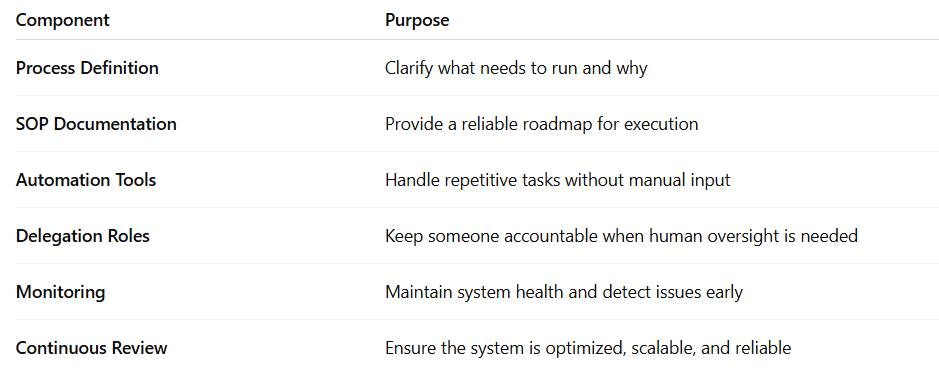How to Build Systems That Run Without You
Learn how to design business systems that operate independently—saving time, reducing risk, and empowering growth. Structured guidance for researchers and solution providers.
8/19/20253 min read


Want your business to keep running smoothly even when you're not actively managing it?
Building independent systems is less about complexity and more about thoughtful structure, reliable tools, and disciplined protocols.
Here’s a clear guide to creating workflows that deliver consistent results with minimal oversight.
1. Clarify Mission-Critical Processes and Goals
Begin by identifying the highest-impact business tasks you want your system to manage on autopilot.
Set measurable standards—like timing, quality, or output—so the system can self-regulate and track effectiveness.
List core processes (e.g., client onboarding, reporting, social media publishing)
Define metrics that reflect success (e.g., email open rate, client feedback time)
Prioritize workflows by recurring frequency and business visibility
2. Document Standard Operating Procedures (SOPs)
Clear, step-by-step SOPs serve as an instruction manual for anyone or anything executing your processes.
With documented rules and templates in place, systems can run reliably even when you’re unavailable.
Develop detailed guides or checklists for recurring tasks
Include tools, login info, approval steps, and fallback options
Store SOPs in a shared drive or knowledge base for easy access
3. Automate Routine and Rule-Based Tasks
Let technology handle predictable, repetitive work so you don’t have to.
By automating parts of your workflow—like emails, data transfers, or reminders—you reduce manual effort and error risks.
Use tools like Zapier, Integromat/Make, or native integrations
Set up triggers such as form submissions, new leads, or calendar events
Automate follow-up emails, data syncing, and report generation
4. Delegate with Clear Ownership and Accountability
Even automated systems need people to notice, fix, and improve them.
Assign roles and responsibilities to trusted team members who can monitor system health and step in when exceptions arise.
Appoint a systems steward or operations lead for each major process
Define decision thresholds and escalation points in the workflow
Schedule periodic reviews to optimize procedures or tools
5. Monitor Performance with Dashboards & Alerts
Maintain visibility without micromanaging by using dashboards, reports, and notification systems.
Proactive tracking enables early detection of issues—so fixes can be applied before impact grows.
Build dashboards using tools like Google Sheets, Data Studio, Airtable, or Notion
Set thresholds for alerts—uncompleted tasks, missed deadlines, or errors
Configure automated notifications (email, Slack, SMS) for relevant stakeholders
6. Test and Refine Through Regular Reviews
Systems should evolve with your business. A regular check cycle helps maintain relevance and efficiency.
Use real data and team feedback to fine-tune workflows, remove bottlenecks, or upgrade tools where needed.
Schedule quarterly or semiannual workflow audits
Gather input from users and stakeholders for improvements
Track system KPIs and compare progress over time
✅ Quick Summary of Structural Strategy
Conclusion
A well-built system doesn’t just operate on command—it runs itself.
With clear tasks, documented procedures, effective automation, and smart delegation, your business can thrive without constant oversight.
If you’d like tools, templates, or implementation support to build resilient systems, Saravapro provides practical consulting and solutions tailored to your workflow needs.








SARAVA PRO
Expert virtual assistance for your business needs.
Contact us
Focus
+91 9952642607


